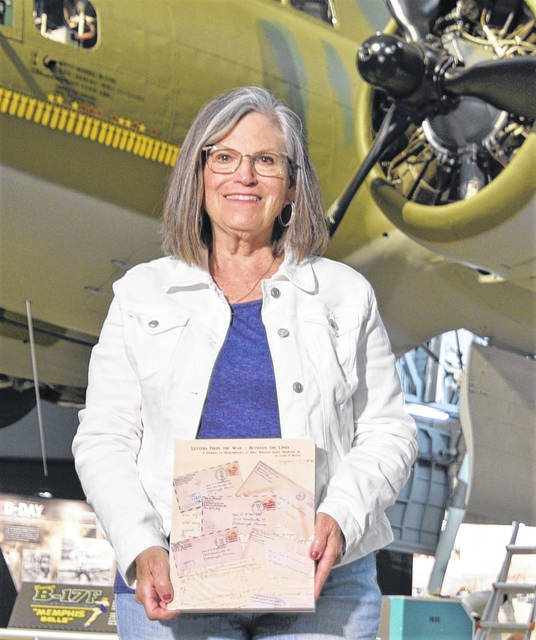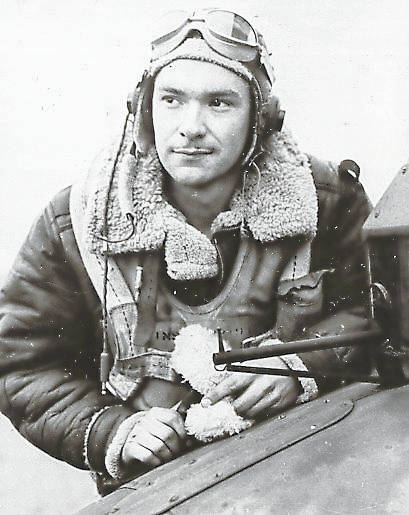

For local artist and crafter Elaine Balsley, who teaches art and crafting at her home studio between New Vienna and Highland, writing a book about her late uncle who was killed in action in World War II was an on-again, off-again proposition dating back to the mid ’90s.
A familiar face at the Cabin Fever Arts Festival held annually at Southern State Community College, Balsley told The Times-Gazette when the festival was cancelled this year due to the coronavirus pandemic, the only good thing to come out of the statewide lockdown was that it gave her the time to finally write the manuscript that would tell the story of an uncle she never knew, but who the family always talked about in the years she was growing up.
“My mother and my aunt talked about Uncle Billy all the time, so I just felt like I knew this guy,” she said.
An accomplished artist in her own right, she recently exchanged her paint brush and canvas for a word processor to paint the story of Staff Sgt. William J. McQuoid Jr., a tail gunner on a B-17 bomber that was shot down on his 21st bombing mission over Nazi Germany in 1944.
“We moved from Pittsburgh in 1994, and moved my mother with us,” Balsley said, “and as I was packing up things, I came across this box that was full of letters that I had never seen before.”
The old and yellowed letters were those that her uncle wrote home after enlisting. They detailed his thoughts, feelings and concerns as he went through basic training, various duty stations, and up to being assigned to the 447th Bomb Group with the Eighth Air Force in England.
“I wish I’d gotten to know him,” she said. “But this was the best I could do, and his letters to home are really what the book is all about.”
While they were addressed mainly to her mother and aunt, Balsley also found letters from the War Department and U.S. Army Air Corps that told of personnel he had served with, missions he had flown, the aircraft he was assigned to — and his appointment with destiny on May 12, 1944.
Their target that day, according to government transcripts, was an aircraft repair depot at Zwickau, about 40 miles south of Liepzig.
In a letter dated Aug. 30, 1945, the father of the only survivor of McQuoid’s aircraft responded to a letter written to his son by a grieving mother, telling her that he was in “a rest camp in Georgia.”
Robert Johnston’s father wrote: “There isn’t very much to tell. When the plane left formation, after being hit, they headed for Switzerland, when about six miles from the border, they were hit by another shell, which broke the plane in two. Bobbie lost consciousness and when he came to, he was a German prisoner. He doesn’t recall opening the parachute — all he recalls was the explosion.”
The letter continued, “Bill was all right until the second shell hit the plane and he was fighting at his post until the second hit. Bobbie said that you should be very proud of him. No one from the plane was saved outside of Bobbie.”
Balsley’s research for the book revealed that the average life expectancy for a B-17 tail gunner was about two weeks, or 14 missions.
She described the tail gunner as being almost on his knees, sitting on a modified bicycle seat, all the while attempting to maneuver a machine gun in a very narrow space at the rear of the aircraft.
The position was usually reserved for a person who was slight of build, Balsley said, and military records showed that her uncle weighed around 135 pounds. “If he was built like my mother, he was short, maybe about five-foot-three,” she said.
“He was an artist, too, and enrolled for one year before the war at Carnegie Tech in Pittsburgh taking art classes, and since I’m an artist as well, I just felt this connection with him,” she said. “And he was just like any other little brother you might see in a family, and he was always pulling something on my mother since as the oldest, she was supposed to keep an eye on the kids when the parents weren’t around, so you can get an idea how that went.”
The only surviving example of his artistic skills, a watercolor painting, hangs in her home.
Interspersed throughout the book in between the letters is original poetry and prose written by Balsley, which she said was an attempt at conveying what he felt and what was going through her uncle’s mind when he was writing all those letters to home.
Included in the book are 12 appendices of information related to the B-17 Flying Fortress, the 447th Bomb Group, the Curtis-Wright propeller factory in Pittsburgh where he worked before entering the service, and other information for students of the war effort and aircraft enthusiasts.
The hardcover book “Letters from the War: Between the Lines” is available from Amazon.com for $39.95 plus shipping and sales tax.
Reach Tim Colliver at 937-402-2571.



